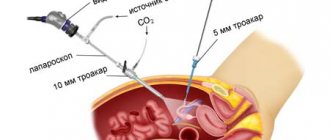05/04/2020 206 Ultrasound
Author: Tatyana
Ultrasound in the 3rd trimester is performed to assess the development of the fetus and the readiness of the mother’s reproductive organs for childbirth. The procedure is included in the mandatory plan and is no different from previous studies.
- 2
How to prepare for your last ultrasound - 3
Norms of baby development and interpretation of results - 3.1
Fetal fetometry by week: table - 3.3
Attention to the placenta! - 3.4
The amount of water surrounding the child - 3.5
Baby's heart rate - 3.6
Condition of female reproductive organs - 3.7
Photo gallery
3.2
Umbilical cord blood flow examination
What is the price?
Video
Comments and Reviews
What ultrasound determines pregnancy?
Sometimes an ultrasound of the pelvic organs helps to understand whether a woman is pregnant.
It is in the small pelvis that the uterus is located, where the chorion is fixed, as well as its appendages. Ultrasound can detect both normal and ectopic pregnancy. This ultrasound is performed after 1-2 weeks of missed period. Pregnancy can be detected not only by the detection of a fertilized egg, but also by an increase in the thickness of the endometrium to 25 mm, as well as a large corpus luteum.
During a normal pregnancy, 3 scheduled ultrasounds are performed: at 10-12, 20-22 and 30-36 weeks. If a violation is suspected or to confirm the diagnosis, additional studies may be prescribed.
The most accurate results in this case are provided by transvaginal ultrasound. During the procedure, a special thin sensor is used, which is inserted into the vagina. A condom is first put on it. The sensor is very thin, pain and discomfort are excluded. It is located at a minimum distance from the uterus. It is completely safe and does not cause any threat of miscarriage or cause any discomfort.
The advantages of ultrasound in diagnosing pregnancy are the most accurate determination of timing. You can set the gestation time to the nearest day. This also allows you to accurately calculate your due date. Studies at 10-12, 20-22, 30-36 weeks do not have such accuracy due to the fact that each child develops individually in the womb.
What studies are included in the final stage of prenatal diagnosis?
The 3rd screening of pregnant women is a set of diagnostic procedures, which, according to plan, is carried out from the 30th to the 35th obstetric week. It is aimed at the final assessment of the condition of the unborn child and the reproductive organs of the mother and consists of:
- Transabdominal ultrasound is a radiological diagnosis in which ultrasound waves penetrate the patient’s internal organs through the anterior abdominal wall.
- Dopplerography, which is an additional study and is carried out to assess the speed and nature of blood flow, the degree of patency of the vascular network of the placenta, fetus and uterus.
- Cardiotocography - continuous synchronous recording of the heart rate (heart rate) of the fetus and muscle tone of the uterus.
- “Triple biochemical test” - determining the levels in the blood of: human chorionic gonadotropin - a hormone that is secreted by the placenta from the moment a woman manages to become pregnant, ɑ-fetoprotein - a complex glycoprotein, the synthesis of which occurs in the liver, gall sac and intestinal epithelium of the embryo associated with pregnancy plasma protein-A.
The purpose of this comprehensive diagnosis is to confirm already discovered pathologies of fetal development or to identify previously undiagnosed anomalies.
How is the third trimester of pregnancy different from others?
Before we unambiguously answer the question of pregnant women, when is the third ultrasound done, let’s look at the features of the final stage of gestation, which begins from the 29th obstetric week. Despite the change in the physiological and psychological state of the expectant mother, all this time passes in anticipation of meeting the baby.
At the beginning of the 30th week, the weight of the fetus approaches one kilogram, and its height is about 35 cm. During this period of intrauterine development, the baby can see, hear and distinguish voices, his taste buds develop, his brain, internal organs and nervous system improve. In the eighth month, the child’s body and organism improve - he is able to breathe, suck, swallow and even write, his nails grow, his nose and ears become cartilaginous.
By the end of the seventh month, the child’s figure changes - the dimensions of his body, head and limbs acquire the correct proportions, skin folds straighten out, his height reaches 40 cm, weight - up to 1 kg 700 grams
It is during this period that boys' testicles descend into the scrotum. Literally, the baby is growing by leaps and bounds, adding more than 1.0 g to his weight. If mom misses a mealtime, he will suck his thumb, a phenomenon that can be clearly observed on a three-dimensional (3D) or four-dimensional (4D) 3rd trimester ultrasound.
At the beginning of the 37th week, fetal growth reaches 45 cm, weight – 2 kg 500 grams. The last, ninth month is very important for both mother and baby - he takes the correct body position (head down), his activity noticeably decreases and the skin becomes smooth. It is difficult to say the exact date of the meeting of parents with their baby - it can happen from 38 to 42 obstetric weeks.
How is an ultrasound performed at 10-12 weeks?
The examination method is chosen by the treating gynecologist. Most often, the study is performed transabdominally - through the abdominal wall. The procedure algorithm is simple:
- The woman sits or lies down on the couch;
- A doctor or nurse applies a sound-conducting gel to the woman's abdomen;
- The doctor places the sensor on the abdomen and slowly moves it over the surface;
- The image is displayed on the monitor.
The procedure lasts a few minutes, after which the pregnant woman can immediately return to her usual activities. An ultrasound scan during pregnancy does not require any special preparation; it can be done at any time of the day.
For special indications, ultrasound is performed transvaginally. This is necessary when:
- Attachment of the chorion or placenta at a low level;
- The position of the fetus is difficult for measuring the collar area or other parts of the body;
- The need to assess the degree of isthmic-cervical insufficiency;
- Diagnosis of inflammation of the appendages or neoplasms in a pregnant woman.
How to perform an ultrasound on a pregnant woman
Ultrasound scanning can be divided according to the method of introducing the device into the female body into transvaginal (through the vagina), transrectal (through the rectum) and transabdominal (by driving along the lower part of the anterior abdominal wall).
More often, the technique is performed transabdominally and is one of the most painless and safe for both subjects, and it is also quite simple and short-lived. The patient is asked to lie down completely on the couch, but a semi-sitting position is also possible. After taking the desired position, the pregnant woman exposes her tummy, and a special transparent gel is applied to the skin and the sensor itself for a better signal.
Using the sensor, the specialist moves through the area under study several times, making repeated drives in those areas that need additional attention. Having recorded his observations, the doctor removes the sensor. A pregnant woman wipes the gel from her skin with a paper napkin or an ordinary towel and gets dressed. All that remains is to wait for the results of the examination.
Ultrasound at 21-22 weeks
The second ultrasound shows the size of the fetal body parts, its anatomy, and internal organs. Allows you to again clarify the duration of pregnancy, identify developmental delays, and find pathologies of the placenta, uterus, cervix, and umbilical cord. The maturity of the placenta is determined, premature aging is determined, and the amount of water is determined. At this time, the sex of the child is most often determined.
The second ultrasound is performed only transabdominally - transvaginal examination is not prescribed until after birth. The procedure is similar to the first ultrasound.
Interpretation of results
From 30 to 34 obstetric weeks, some minor deviations from existing normal parameters are possible - this is not evidence of abnormalities in the development of the baby. To dispel all doubts of future parents, a qualified specialist monitoring the course of the gestational period will explain in detail the final ultrasound data, which includes the following indicators:
How to determine contractions using CTG?
- Fetometric measurements of the fetus: bi-parental diameter, head circumference, fronto-occipital size, abdominal girth, total weight, length of the femur and humerus.
- Placenta parameters: thickness, degree of maturity, localization.
- Conditions of amniotic fluid.
- Distances from the placenta to the cervical canal.
- Biophysical profile: motor activity, intrauterine respiration, position.
- Functional activity of the cerebral cortex.
- Conditions of the pelvic organs of the expectant mother.
Ultrasound studies the structure of the musculoskeletal system, brain, heart muscle, respiratory system, spinal column, and internal organs.
When is the last time an ultrasound is performed during pregnancy?
An ultrasound scan at the third screening is done at 30-31 weeks. As in the second study, the third ultrasound evaluates the condition of the uterus, placenta, umbilical cord, waters and the fetus itself. In addition, it is necessary to determine the presentation of the embryo - the position inside the uterus. Normally it is cephalic, that is, the fetus lies head down, with the top of the head towards the exit. It is important to establish the position of the placenta, the length of the cervical canal, and check the quality of the placenta.
The course of the third study does not differ from the course of the previous ones. An ultrasound is performed only on the abdominal wall.
Norms of baby development and interpretation of results
The norms of baby development and interpretation of the results concern:
- weight and main dimensions of the fetus;
- umbilical cord blood flow;
- placenta;
- amount of amniotic fluid;
- heart rate frequency.
The general condition of the expectant mother’s body is assessed separately.
Fetal fetometry by week: table
Only a doctor can correctly decipher fetometry data, but there are standard norms that are worth paying attention to.
In the table you can see the standard sizes of the baby depending on the week of pregnancy:
| Week of pregnancy | Fruit weight, g | Coccygeal-parietal size (CTR), cm | Chest girth - OG (GDK), mm | Thigh length (DB), mm | Biparietal size (BPR), mm |
| 11 | 11 | 6,8 | 20 | 7 | 18 |
| 12 | 19 | 8,2 | 24 | 9 | 21 |
| 13 | 31 | 10 | 24 | 21 | 24 |
| 14 | 52 | 12,3 | 26 | 16 | 28 |
| 15 | 77 | 14,2 | 28 | 19 | 32 |
| 16 | 118 | 16,4 | 34 | 22 | 35 |
| 17 | 160 | 18 | 38 | 24 | 39 |
| 18 | 217 | 20,3 | 41 | 28 | 42 |
| 19 | 270 | 22,1 | 44 | 31 | 44 |
| 20 | 345 | 24,1 | 48 | 34 | 47 |
| 21 | 416 | 25,9 | 50 | 37 | 50 |
| 22 | 506 | 27,8 | 53 | 40 | 53 |
| 23 | 607 | 29,7 | 56 | 43 | 56 |
| 24 | 733 | 31,2 | 59 | 46 | 60 |
| 25 | 844 | 32,4 | 62 | 48 | 63 |
| 26 | 969 | 33,9 | 64 | 51 | 66 |
| 27 | 1135 | 35,5 | 69 | 53 | 69 |
| 28 | 1319 | 37,2 | 73 | 55 | 73 |
| 29 | 1482 | 38,6 | 76 | 57 | 76 |
| 30 | 1636 | 39,9 | 70 | 59 | 78 |
| 31 | 1779 | 41,1 | 81 | 61 | 80 |
| 32 | 1930 | 42,3 | 83 | 63 | 82 |
| 33 | 2088 | 43,6 | 85 | 65 | 84 |
| 34 | 2248 | 44,5 | 88 | 66 | 86 |
| 35 | 2414 | 45,4 | 91 | 67 | 88 |
| 36 | 2612 | 46,6 | 94 | 69 | 89,5 |
| 37 | 2820 | 47,9 | 97 | 71 | 91 |
| 38 | 2992 | 49 | 99 | 73 | 92 |
| 39 | 3170 | 50,2 | 101 | 75 | 93 |
| 40 | 3373 | 51,3 | 103 | 77 | 94,5 |
Umbilical cord blood flow examination
Ultrasound Dopplerography, or Dopplerography, is one of the ultrasound diagnostic methods that allows you to effectively determine the speed of blood movement through the vessels of the umbilical cord. The doctor can make a conclusion about the functioning of the cardiovascular system based on the results of an analysis of the heart, umbilical cord and uterine artery.
Which ultrasound is better during pregnancy - 3D or simple?
The difference between 3D ultrasound during pregnancy and a regular one is only in the resulting image. During a normal examination, it is understandable only to the doctor, but the patient, as a rule, has difficulty examining the picture. Three-dimensional ultrasound allows you to see a clear three-dimensional image in color. High contrast and clarity allow you to examine the embryo in detail even at the earliest stages. If desired, a woman can get the first photo of the child printed on a printer from the doctor.
These types of ultrasound do not differ in terms of the level of impact on the child or other parameters - both are harmless to the fetus and painless for the mother. To get more positive emotions, it is better to choose a 3D ultrasound, but if it is not possible, you should not be upset.
Video: Ultrasound during pregnancy!
Attention!
This article is posted for informational purposes only and under no circumstances constitutes scientific material or medical advice and should not serve as a substitute for an in-person consultation with a professional physician.
For diagnostics, diagnosis and treatment, contact qualified doctors! Number of reads: 7614 Date of publication: 11/13/2017
Gynecologists - search service and appointment with gynecologists in Moscow
Ultrasound before birth
In the maternity hospital, an ultrasound diagnostic doctor is on duty 24 hours a day, who conducts ultrasound examinations in the emergency department . The purpose of ultrasound upon admission is to assess the condition of the baby and the woman. The height and weight indicators and heart rate of the child, as well as blood flow in the vessels of the fetus and mother, must be measured.
As a rule, on the 3rd–4th day after a natural birth and the 5th–6th after a cesarean section, the doctor will again order an ultrasound. For what? It is necessary to make sure that the reverse development of the uterus is proceeding at a normal pace, there are no blood clots or placental remains in its cavity, and there are no inflammatory processes. Only after this can you prepare for the long-awaited discharge and return to the walls of your home with the priceless creature in your arms!











